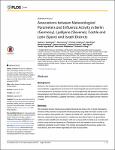Associations between Meteorological Parameters and Influenza Activity in Berlin (Germany), Ljubljana (Slovenia), Castile and León (Spain) and Israeli Districts
Soebiyanto, Radina P.
Gross, Diane
Jorgensen, Pernille
Buda, Silke
Bromberg, Michal
Kaufman, Zalman
Prosenc, Katarina
Socan, Maja
Alonso, Tomás Vega
Widdowson, Marc-Alain
Kiang, Richard K.
Background: Studies in the literature have indicated that the timing of seasonal influenza epidemic varies across latitude, suggesting the involvement of meteorological and environmental conditions in the transmission of influenza. In this study, we investigated the link between meteorological parameters and influenza activity in 9 sub-national areas with temperate and subtropical climates: Berlin (Germany), Ljubljana (Slovenia), Castile and León (Spain) and all 6 districts in Israel. Methods: We estimated weekly influenza-associated influenza-like-illness (ILI) or Acute Respiratory Infection (ARI) incidence to represent influenza activity using data from each country’s sentinel surveillance during 2000–2011 (Spain) and 2006–2011 (all others). Meteorological data was obtained from ground stations, satellite and assimilated data. Two generalized additive models (GAM) were developed, with one using specific humidity as a covariate and another using minimum temperature. Precipitation and solar radiation were included as additional covariates in both models. The models were adjusted for previous weeks’ influenza activity, and were trained separately for each study location. Results: Influenza activity was inversely associated (p
Files in this item
No license information

